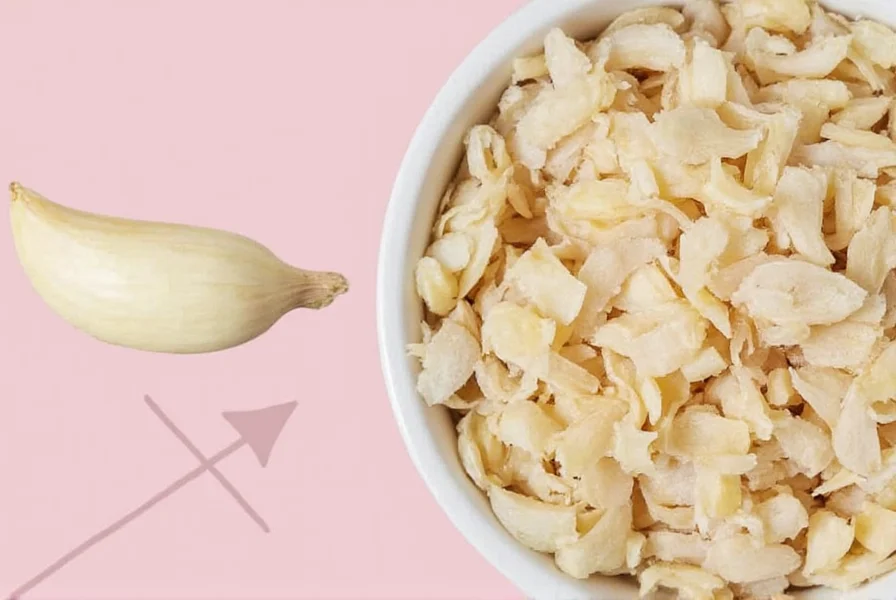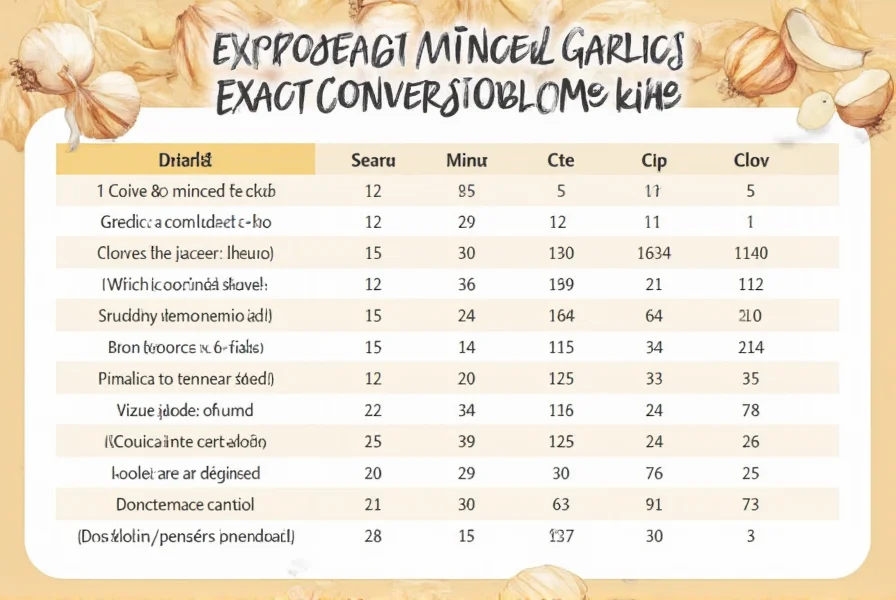Understanding garlic measurements is essential for consistent cooking results. Whether you're following a recipe that calls for minced garlic but only have whole cloves, or vice versa, knowing the exact conversion prevents flavor imbalances in your dishes. This guide provides authoritative measurements based on culinary standards and practical testing in professional kitchens.
Garlic Conversion Fundamentals
Garlic measurements vary based on clove size and preparation method. The standard conversion accepted by culinary professionals is straightforward but requires attention to detail for optimal results. When converting cloves to minced garlic, remember that the size of individual cloves can significantly affect the final measurement.
| Whole Garlic Cloves | Minced Garlic Equivalent | Garlic Paste Equivalent |
|---|---|---|
| 1 small clove (1/2" long) | 1/4 teaspoon | 1/8 teaspoon |
| 1 medium clove (3/4" long) | 1/2 teaspoon | 1/4 teaspoon |
| 1 large clove (1" long) | 3/4 teaspoon | 3/8 teaspoon |
| 1 extra-large clove (1 1/4" long) | 1 teaspoon | 1/2 teaspoon |
| 3 cloves | 1 1/2 teaspoons | 3/4 teaspoon |
| 6 cloves | 1 tablespoon | 1 1/2 teaspoons |
Factors Affecting Garlic Measurements
Several variables influence the precise conversion from whole cloves to minced garlic. Understanding these factors helps you adjust measurements for perfect results every time. The size variation among garlic cloves is the most significant factor—garlic bulbs contain cloves of different sizes, with outer cloves typically larger than inner ones.
Freshness also impacts volume. Older garlic cloves become drier and yield less minced product than plump, fresh cloves. The mincing technique matters too: finely minced garlic packs more densely than roughly chopped, affecting volume measurements. When using jarred minced garlic, remember it often contains preservatives that can alter both volume and flavor intensity compared to freshly minced.

Practical Application in Recipes
Knowing how to convert cloves to minced garlic becomes crucial when following recipes that specify one form but you have the other available. For most savory dishes, maintaining the proper garlic ratio ensures balanced flavor without overwhelming other ingredients. In delicate sauces or dressings, precise measurements prevent garlic from dominating the flavor profile.
When substituting jarred minced garlic for fresh, use 10-15% less than the conversion suggests, as preserved garlic often has a slightly milder flavor. For recipes where garlic plays a starring role—like garlic bread or aioli—the difference between fresh and pre-minced becomes more pronounced, making fresh preparation preferable for optimal flavor.
Proper Mincing Technique for Accurate Measurements
To achieve consistent measurements when mincing garlic at home, follow these professional techniques. First, peel the clove and remove the germ (the green sprout in the center) if present, as it can impart bitterness. Place the flat side of a chef's knife over the clove and press down firmly to crush it, which releases enzymes that develop flavor.
Chop the garlic in a rocking motion, gathering the pieces and continuing to chop until you achieve a fine, uniform mince. For the most accurate measurements, lightly pack the minced garlic into your measuring spoon rather than heaping it. This technique yields measurements closest to the standard conversion ratios used in recipe development.
Storage Considerations for Both Forms
Understanding how storage affects garlic helps maintain consistent flavor in your cooking. Whole garlic bulbs stored in a cool, dark place maintain peak quality for 3-5 weeks. Once cloves are separated, they last about 10 days at room temperature. Minced garlic, whether homemade or store-bought, has a significantly shorter shelf life.
Freshly minced garlic stored in an airtight container in the refrigerator remains usable for 5-7 days, though its potency diminishes noticeably after the first 48 hours. Jarred minced garlic typically contains citric acid or other preservatives that extend its shelf life to 18-24 months unopened, but once opened, it should be used within 18-24 days. Always check for off odors or discoloration before using stored garlic products.
When Substitutions Work Best
Not all recipes tolerate garlic substitutions equally. For dishes with long cooking times like stews, braises, and soups, the difference between fresh and pre-minced garlic becomes less noticeable as flavors meld. In these applications, the standard conversion works reliably. However, for raw applications like salad dressings, dips, and marinades, fresh garlic provides superior flavor complexity that jarred versions cannot match.
When making garlic-infused oils or butters, always use freshly minced garlic for the most vibrant flavor. The enzymatic reactions that create garlic's characteristic aroma compounds are most active in freshly prepared garlic. For emergency substitutions when you've run out of fresh garlic, reconstitute freeze-dried garlic granules with a few drops of water to approximate fresh minced garlic.
How many teaspoons is one garlic clove when minced?
One medium garlic clove yields approximately 1/2 teaspoon of minced garlic. Small cloves produce about 1/4 teaspoon, while large cloves can yield up to 1 teaspoon of minced garlic. For recipe accuracy, always consider the size of your specific garlic cloves when making conversions.
Can I substitute jarred minced garlic for fresh cloves in recipes?
Yes, you can substitute jarred minced garlic for fresh cloves using the standard conversion ratios, but use 10-15% less jarred garlic than fresh. Jarred versions often contain preservatives that slightly alter flavor intensity. For best results in raw applications like dressings or aioli, fresh garlic is preferable as it provides more complex flavor compounds.
Why does my minced garlic measurement seem different than the standard conversion?
Garlic clove size varies significantly between bulbs and even within the same bulb. Older garlic dries out and yields less minced product. Your mincing technique also affects volume—finely minced garlic packs more densely than roughly chopped. For consistent results, measure after mincing rather than estimating based on clove count alone.
How much jarred minced garlic equals 4 cloves of fresh garlic?
Four medium garlic cloves equal approximately 2 teaspoons of freshly minced garlic. When using jarred minced garlic, start with 1 3/4 teaspoons as a substitution. Remember that jarred garlic often has a slightly milder flavor, so you may need to adjust to taste, particularly in raw applications where garlic flavor remains prominent.
Does the conversion differ for roasted garlic?
Yes, roasted garlic yields less volume than raw minced garlic due to moisture loss during cooking. One roasted medium clove equals approximately 1/3 teaspoon of minced roasted garlic. Roasted garlic also has a milder, sweeter flavor, so you may need to use slightly more than the standard conversion to achieve comparable flavor impact in recipes.











 浙公网安备
33010002000092号
浙公网安备
33010002000092号 浙B2-20120091-4
浙B2-20120091-4